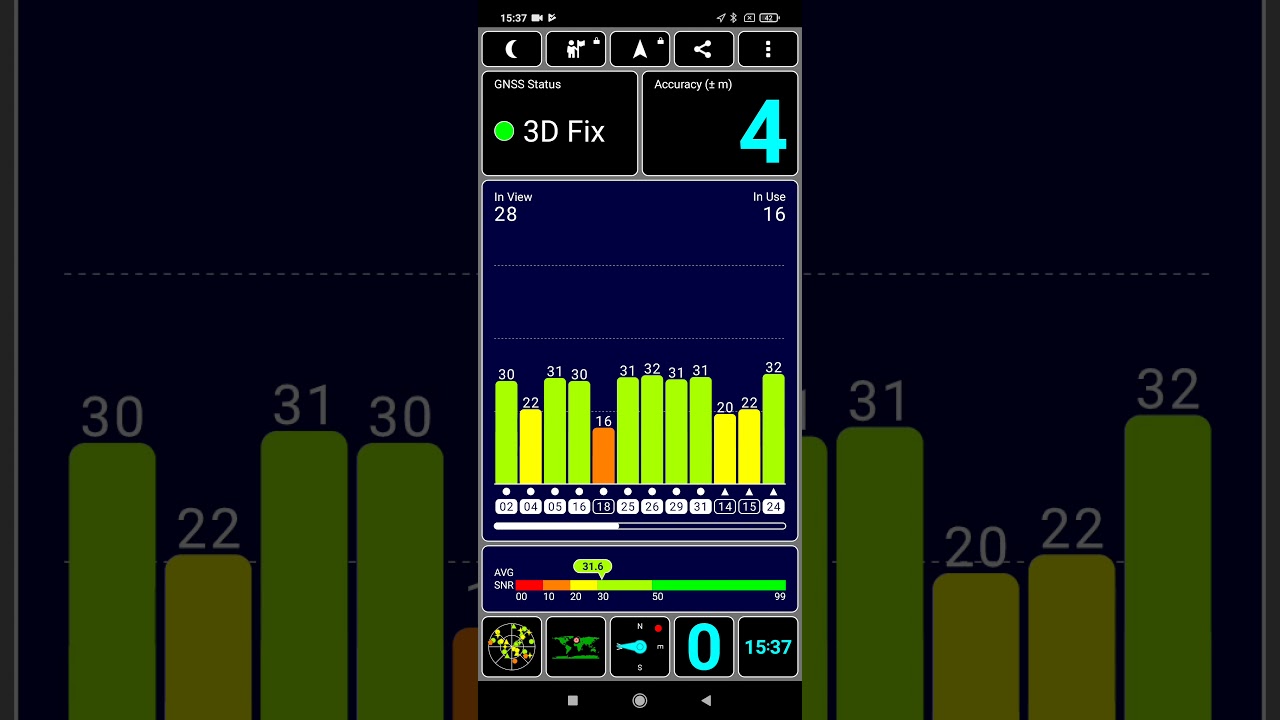Smartphones
Poco X3 Pro : test / review
Published on: 24-03-2021 / Modified: 11-12-2022
The Poco family has grown, two new models were announced at the end of March to be marketed in early April, these are the Poco X3 Pro and the Poco F3. This article will focus on the Poco X3 Pro.
I had tested the Poco X3 last year, this phone had a good score except for network sensitivity where it was among the worst phones tested. The Poco X3 was marketed aimed at gamers because it offered a very interesting price / performance ratio. I found at the time that this positioning was too limited because the Poco X3 could meet the expectations of a much larger audience than gamers. The Poco X3 Pro seems to follow the same path taking a big leap forward in performance and here too Poco is aimed at a gaming audience but again I think this phone will appeal to a wider audience.
What are the changes made by this Poco X3 Pro compared to the previous model?
The Poco X3 Pro broadly incorporates the specificities of the X3 range, it is very similar in size and its design is also very similar, so it is not at the level of its exterior appearance that it will stand out from the previous model. The screen also appears to be identical (size, resolution and IPS LCD in both cases). The weight is the same (215 gr)
For the photo part, the front camera seems to be the same, on the other hand for the main sensor at the back I note a regression. The Poco X3 used the Sony IMX 682 whereas the Poco X3 Pro uses the Sony IMX 582. The Sony IMX 582 is not a bad photo sensor but this regression is curious.
The novelty comes from the CPU and GPU which should allow performance to be increased by 50% compared to the previous model, this performance increase will be accompanied by an adapted cooling system.
Why should we buy it with so few new things?
The Poco X3 stood out for its price / performance ratio, it's the same with the Poco X3 Pro, it is launched at $ 199 from April 1. The Poco X3 Pro therefore becomes the most powerful phone in this price range.
If you want to take advantage of this introductory offer: Poco X3 Pro at $ 199 (Aliexpress exclusive)
Manufacturer web site:
https://www.po.co/global/
Site where I have bought the Poco X3 Pro: https://s.click.aliexpress.com/e/_AOTTLS
Structure of my tests
I test the phones according to a pre-established structure (see below) to provide you with as much information as possible. Unfortunately, this takes a long time. Some tests like network performance tests take several days and for photo tests I sometimes have to wait until the weather is suitable to take pictures in good conditions. I am therefore obliged to publish the tests step by step, so I invite you to come back if the test is not complete at the time of your visit.Price Poco X3 Pro
The list below shows the prices for the Poco X3 Pro from more than 50 sites around the world. If you are not satisfied with any price, you can subscribe to a price alert to be the first to be notified when the price drops.The above links are affiliate links from companies such as Amazon, Gearbest, Aliexpress,... If you appreciate my work, I would be grateful if you could purchase these products through these links. It costs you absolutely nothing but I get a small commission that allows me to buy the material I test. Thank you very much!
Timeline
04/01/2021 Order of the Poco X3 Pro in presale on Aliexpress.04/07/2021 I have received the Poco X3 Pro, so the test can begin.
Why this phone?
Since I have to buy most of the phones that I test and don't have unlimited means, I have to make choices like you and sometimes those choices mean I have to buy a phone based on a hunch because no one has it. 'tested before. Fortunately, there are elements that allow me to improve my intuition and among those there is the history of the brandThe Poco brand reappeared on the market in 2020 after few years of silence, I bought all the Poco that were launched in 2020 (Poco F2 PRo, Poco X3, Poco M3) and each time Poco has managed to establish itself as the best alternative to Xiaomi in each segment of price. So I don't take a lot of risks buying this new Poco blindly.
The Poco X3 Pro does not bring great innovations, this is also rarely the case at Xiaomi, its strong point is its price / performance ratio. There is currently nothing more powerful than the Poco X3 Pro at this price point. Power is an argument for gamers but not only because beyond performance, the Poco X3 Pro takes the good basics of the Poco X3 which was already a good phone. If you missed the X3, then you can catch up on the X3 Pro with a more capable phone. Gamer or not gamer, so it doesn't matter.
Unpacking
The box of the Poco X3 Pro is quite classic, it contains the phone wrapped in protective plastic, a charger, a USB-C cable and a soft and transparent silicone shell. Poco added some Poco stickers in the sleeve with the manual, I don't know if they are for the phone or if you need to stick them on your car but I found it funny. Poco undoubtedly relies on its customers to talk about the brand.
First configuration
The first configuration of the Poco X3 Pro is in all respects similar to the brand's other phones running MIUI 12 with still this partially subtle approach to encourage you to use the Xiaomi cloud rather than the Google one. The phone can recover applications from another phone and it turns out that my last backup was that of the Poco X3. So I used this backup to configure the Poco X3 Pro and I was very surprised by the installation speed of the 81 applications in my backup. This process can sometimes take a long time on slower phones, I didn't have to wait longer than 10 minutes on the Poco X3 Pro. This comes from the storage technology used by the Poco X3 Pro, it uses UFS 3.1 which can double your file transfer speed. So this is not just a selling point, it can be felt very quickly when using the phone.Finish
For the rest of the phone it's really very classic, the phone is imposing and heavy but it offers a huge screen area of 6.67 inches. It is in any case not in its format and its design that the Poco X3 Pro will stand out.
When I tested the previous model, I was often asked the question about the gaming orientation of the model. Poco undoubtedly wants to push this phone towards gamers but that does not mean that it is not suitable for non-gamers, on the contrary. It's a versatile phone that will appeal to a larger segment of the population, so don't stop at its gaming aspect.
I took some pictures of the Poco X3 Pro next to the previous model and apart from the color you really have to look to find differences.
Specifications
The information below comes from the Device Info HW application. The application provides detailed technical information about the tested phone.The Poco X3 Pro is positioned as a performance-oriented phone for a moderate price, and that's certainly its easiest selling point to explain. I would add to that some other interesting elements like the use of UFS 3.1 memory which has the effect of offering very good read / write performance. In UFS 3.1 the Poco X3 Pro offers a reading speed up to 3x faster than a phone using UFS 2.0.
The Poco X3 Pro is also equipped with a powerful heat dissipation system which not only helps preserve the components when you push performance hard but you won't either. that sometimes unpleasant feeling of heat when playing or filming in 4k. The Samsung Galaxy S20 is a good example of a phone with poor heat dissipation, sometimes it can get so hot that you are going to want to take your hand away. I did a temperature test by running a greedy app for more than 10 minutes, the temperature only rose 8 ° C to reach 32 ° C. It's a great performance.
The screen takes the same basics of what Poco has already done for other models by offering a large IPS LCD screen with a refresh rate of up to 240hz. This will make your gaming experience even smoother.
I took a screenshot of the technical specifications below. I see some differences compared to the previous model like the sound chipset and the magnetometer. The screen does not seem to be the same, that of the Poco X3 Pro indicates a frequency of 60hz where the previous model indicated 120hz.
CPU / GPU Performance
The Poco X3 Pro is equipped with a Qualcomm Snapdragon 860 CPU, I think it is the first phone that is equipped with this CPU. So I don't have a reference in another phone to compare the performance but in theory, the Poco X3 Pro should be able to offer a performance comparable to a Huawei P40 or even a Samsung Galaxy S20. These phones cost 2-3 times more than the Poco. The price / performance ratio is therefore extremely competitive.
The Poco X3 Pro is equipped with a Qualcomm Adreno 640 GPU which also offers a level of performance comparable to what is done at the top of the range. So you can play any game or use any application with this phone and with 6Gb of base memory, multitasking will not be a problem.
Benchmark Antutu/3DMark
I got a score of 486466 points with Antutu, this places the Poco X3 Pro among the best performing phones I have tested. The result does not surprise me, Poco wanted to offer a super powerful phone for a super aggressive price, they took up the challenge because in this price zone, there is nothing that can exceed a Poco X3 Pro ( for the moment anyway).Beyond this result, there is also something else that I wanted to mention. The score is the result of several tests including specific tests on the CPU, GPU, memory and fluidity of the phone. The performance of the CPU is excellent, that of the GPU is even better but the memory score is really impressive because we find here the effect of UFS 3.1, the memory score of the Poco X3 Pro exceeds the score of the Samsung Galaxy S20 which costs 3 times more expensive!
This phone has been positioned as a phone for gamers and it responds well to this expectation but its performance and especially its memory performance make it a particularly fluid phone to use and this would appeal to a audience much larger than that of gamers.
Gaming
To test the performance in game, I download the mobile PUBG game and evaluate the in-game experience, graphics level and depth of vision. This game is quite demanding and should help you evaluating the performance of a phone.

Network performance
The Poco X3 Pro is compatible with most 3G and 4G frequencies in Europe.Signal 4G (before december 2020)
The ability to pick up the network correctly is an essential element for a phone but it is only very rarely measured. To measure a phone's ability to pick up the network, I perform a large number of measurements on the same cells to be able to compare phones under similar conditions. The signal is measured in dBm, a value of -90dBm indicates a worse signal than -70dBm. These measurements are therefore taken under real conditions and not in a laboratory, they are not scientific but give a good indication of performance.
Signal 4G (from December 2020)
I decided to change the methodology for measuring the network because I noticed that the configuration of the mobile network changes over time. This makes it more difficult to compare phones because the conditions are no longer exactly the same.
To overcome this problem, I set up a device that captures 24 hours a day about ten parameters from the mobile network (ex: cell id, rssi, rsrq, snr, frequency,...). I then place the phone next to the device for 24 to 48 hours taking the same measurements so that I can compare them.
Overview of the phones tested with this methodology
The Poco X3 was at the bottom of the 4G signal sensitivity rankings and I have received numerous testimonials that its network connectivity is not very good. The Poco X3 Pro uses a different modem so I expected the results to be better and luckily it is. I carried out more than 1800 measurements to obtain an average of -92.91 dBm with the Poco against -91.45 dBm for my measuring device. The Poco is not the best phone in the ranking, but it is a big step up from the previous model.
Download/Upload speed
To test the download speed, I have identified some 4G cells offering good performance where I test all my devices several times to see what download and upload speed they can achieve.
Wifi performance
To test a phone's ability to receive the network properly, I take measurements near my router and then remotely (and always at the same place). This gives me an average in dBm where a value of -90 dBm indicates poorer performance than a value at -30 dBm.Wifi signal
The Poco X3 Pro uses the same WiFi chip as the Redmi Note 10 and I got a very similar sensitivity score with = 15 dBm near the router and -65 dBm away. It's a good score, the Poco X3 Pro has good wifi sensitivity.
Download/Upload speed
To test the speed in Wifi, I connect to my router in 2.4Ghz and 5Ghz (if available) and use the Ookla application to measure the speed.
GPS performance
To test the quality of the GPS signal I use the Offline Maps application and I make the same train trip in pedestrian mode. Why? In pedestrian mode, the GPS does not artificially correct the signal to stick to the road, it has no markings, so you can see the actual position. I then use an application to measure the accuracy of the signal.

I took a look at the GPS frequencies used and I only saw one frequency for each network (GPS, Galileo, ...).
Battery range
The Poco X3 Pro has a 5160 mAh battery, it is an above average capacity which mechanically translates into good autonomy of 3 to 4 days in normal use and 1 to 2 days in intensive use.I got a battery life very similar to the Poco X3, it's normal because it's exactly the same battery. With the screen on to the maximum, the phone lasts for more than 10 hours and with the screen at 50%, the battery life increases to 28 hours. It's not the best score I got, but it's more than enough to get good battery life. The energy consumption is not linear, if the screen is on at 100% it consumes almost 3 times more than at 50%.
Photo camera test
To test the quality of photos produced by a phone, I do a technical test (resolution, sharpness, chromatic aberration,...) in studio (identical conditions) to evaluate the technical part objectively. From the second half of 2020, I built my own laboratory to take completely objective technical measurements. I then take pictures in real conditions to see how the camera performs. I then evaluate these photos according to my criteria but I publish the photos so that you can evaluate the result according to your criteria.Hardware
The Poco X3 Pro does not innovate at the photo level because it re-uses a sensor launched two years ago. I had already had the opportunity to test the Sony IMX 582 with a Xiaomi in 2019, it was at the time a good photo sensor and it is still the case today but there are other more powerful models. . Poco therefore bet everything on the performance of the phone rather than focusing on the photo as was the case for the Redmi Note 10 Pro. I find it unfortunate but I also understand the reasons which pushed them to do it. If this Poco was a reference in terms of photography, it would compete with other models from Xiaomi.Default app
The default photo application has not changed since MIUI 12, it is overall well designed and allows you to customize the most frequently used modes. I repeat it often but the biggest flaw of this application is to display the settings in superimposition of the photo zone and in full light these settings are absolutely illegible.
Photo quality
Photo test / studio
For its passage in the studio, I obtain the same kind of result as the other models using this sensor. Under artificial light the sensor produces photos that are a little too dark, this can be easily corrected in pro mode by playing with the shutter speed. The level of sharpness is good, the depth of field is quite low, the colors are correctly rendered. No surprise here, the result is quite comparable to other phones in this price range.
Photo test / sunny
Main sensor: Sony IMX 582
On sunny days, the Sony IMX 582 produces good photos with good detail. The photos are correctly exposed, the colors lack saturation a little (the sky tends towards cyan when it was indeed blue), the level of detail is good. When the light goes down, the Sony IMX 582 tends to take pictures that are slightly too dark like the pictures in my studio. This makes it possible to keep a maximum of details, for example at cloud level, but all the rest of the decor is immersed in a darker area. To reduce this problem, limit the presence of the sky to about 1/3 of the photo.
I have sometimes taken the same photo several times alternating AI / HDR and night mode but I did not find that these features produced good results because the AI tends to give a bluish tint to photos and HDR is not very useful if the light is good.
In manual mode (introductory photo of this paragraph), it is possible to force the exposure so that it brings out areas that are too dark and give a little more saturation to the colors , the Sony IMX 582 is capable of producing RAW files that you can edit later with Photoshop.
Ultra wide angle sensor
When the brightness decreases, the underexposure is clearly visible but it has the advantage of keeping the detail at sky level.
Photo test / cloudy
Not yet available / tested
Test photo / night
On the other hand, the ultra wide-angle sensor should be forgotten for this kind of photo, it is not able to capture enough light to properly expose the photo. The photos are very dark and very smooth, the loss of details is really very important.
Gcam works very well on the Poco X3, I added the mention "gcam" on the photos taken with this application. The result is good, but the difference with Xiaomi's night mode is not really obvious. The advantage of Gcam lies in the possibility of using much more advanced settings but not many people will tire of doing this kind of thing because the results with the default settings are already very good. Gcam is a bit slower than night mode but for very dark scenes like a starry sky you can get very good results.
Video quality
Stabilisation

Video normale conditions
1080p video test with zoom

4k video test 30 fps with zoom

The Poco X3 Pro is capable of filming in 4k 30 fps. The quality of the video is quite good, the video is quite sharp, the focus is fast and the exposure changes are not visible. The zoom level is quite good, especially in 4k where the loss of detail still makes it possible to clearly distinguish the geese that I film in the second video. The IMX 582 sensor may not be brand new, but it is still capable of producing good videos.
Video low light
Not yet available / tested
Audio quality
To test the quality of the phone's audio output, I connect the device's audio output to a measuring tool, then play sounds on all frequencies and measure the differences between the original sound and the sound produced by the phone. In this way I measure the phone's ability to correctly reproduce all sounds.Frequency Response
This test is intended to test the device's ability to correctly reproduce all frequencies. The white line in the middle of the graph is the ideal situation and the other colors come from tests on different phones. A deviation from the reference line indicates a deviation from the ideal situation. To see good sound at all frequencies, it is therefore necessary to get as close as possible to the reference line.
Dynamic Range
This test is designed to test a phone's ability to play sounds at different volume levels. Here too, the phones must be as close as possible to the reference.
Noise Level
This test aims to identify if the device under test is able to reproduce sounds without too much noise. A high score indicates a low parasite rate, a lower score indicates a higher presence of parasites.
Screen quality
To test the screen, I use a colorimetric probe that measures the color accuracy of a screen, as well as other parameters to see if a screen is able to correctly reproduce an image. I also test the brightness level to determine if the screen will be able to display an image in full sunlight.Colorimetry
Brightness / Contrast
I measured a contrast of just over 1200: 1, it's a pretty average contrast and as I wrote in the previous paragraph, it's particularly a shame because Xiaomi has shown that they can market a screen Amoled in this price range. This lack of contrast is not a blocking point but it is visible to a trained eye.
I measured a maximum brightness of 470 cd / m² (in sun mode), this is a good score that will allow you to use the screen in almost all conditions brightness, the latest Redmi also do better at this level.
Biometry
The fingerprint sensor is located exactly in the same place as the previous model and that's a good thing, this placement is ideal for positioning the thumb there. The fingerprint sensor responds fairly quickly. From a hardware point of view, Xiaomi uses the exact same sensor on several of these models.Operating system
Not yet available / tested
Encoutered bugs
Not yet available / testedAccessories Poco X3 Pro
Compare Poco X3 Pro with the others
Test / Review conclusion
The Poco X3 had shaken the mid-range by offering the best price / performance ratio, the Poco X3 Pro managed to do even better by offering even more performance for a price similar to the launch price of the Poco X3 in 2020. Xiaomi complicates the life of traditional brands by always offering more for a price lower than the competition but with the Poco brand they have created a competitor for their own brand. Poco thus becomes a competitor for Xiaomi, only the positioning of the product is a little different where Xiaomi is to be considered as a mainstream brand and where Poco is more oriented for gamers.
For around 200 € you have the best performing phone on the market in this price range, nothing comes close to the Poco for the moment. So, yes, everything seems to indicate that this phone is made for gamers but don't stop there. The performance offered by this phone is not only useful to gamers, it is also very useful in all everyday tasks thanks to an ultra fast memory (UFS 3.1). Loading apps, switching between apps, and the responsiveness of the phone will make you feel like your previous phone was really slow.
The Poco X3 Pro is not only a powerful phone, it takes other elements of a recipe that works with for example an ultra fluid screen of 120hz, a large battery of 5160 mAh and a good camera for this price range. The design of the phone is very divisive, it is not as neutral as a Redmi but it is all a matter of taste. I see a lot of comments all over the place about the photo block on the back of the phone, yes it's not very stylish but if that's the only big flaw in the phone it's probably not a big deal.
The Poco X3 had a big weakness in the network sensitivity, this weakness has been fixed on the X3 Pro, the network sensitivity is now much better. If this X3 Pro corrects the major flaw of the X3, what are its weaknesses then? The Poco X3 Pro could undoubtedly do better in some aspects but we must not forget its price point which erases almost all the parts of this test where the Poco X3 Pro is just average. So I'm not going to look for weaknesses to fill in boxes, if the photo is important to you, there are probably better but that does not mean that the Poco X3 Pro is bad.
What annoyed me a little every day was a small detail. The back of the phone is made of two types of coverings, when I felt the change from one to the other, I always felt like I had scratched my phone. The smooth part stands out a little more than the matte part and you can feel it when you grip it.
Strengths
- unbeatable price / performance ratio
- memory speed, responsiveness of the phone
- 120hz screen well calibrated in standard mode
- good 4G and wifi sensitivity
- good sound quality
Weaknesses
- optical unit at the rear rather protruding
- size (size / weight)
Alternatives to this product
There is no real equivalent to the Poco X3 Pro in this price range, the Redmi Note 10 and Redmi Note 10 Pro are certainly the closest to the Poco in terms of price / performance. For a phone offering the same level of performance from Samsung, it is necessary to go beyond 400 €. Among other Chinese brands, I don't see any direct competition in this segment either, Poco has managed to create a genre in the mid-range. I could compare the Poco to the Nubia or Black Shark but here too the price point is significantly higher.
 LAURENT WILLEN
LAURENT WILLENHead of myself on this blog
I share my passions on my blog in my free time since 2006, I prefer that to watching nonsense on TV or on social networks. I work alone, I am undoubtedly one of the last survivors of the world of blogs and personal sites.
My speciality? Digital in all its forms. I have spent the last 25 years working for multinationals where I managed digital teams and generated revenues of over €500 million per year. I have expertise in telecoms, media, aviation, travel and tourism.










































Questions/Comments